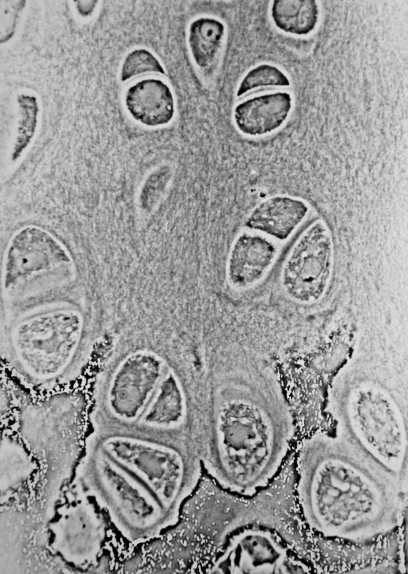Cartilage
Cartilage is a flexible connective tissue found in many parts of the body. It can bend a bit, but resists stretching.
| Cartilage | |
|---|---|

| |
| Light micrograph of undecalcified hyaline cartilage showing chondrocytes and organelles, lacunae and matrix. |
Its main function is to connect bones together. It is also found in the joints, the rib cage, the ear, the nose, the throat and between the bones of the back. Another function of cartilage is to create a place on which bones can form when they are first developed. It also helps to protect the places where bones work against each other: the joints. In some fish like sharks (Chondrichthyes), cartilage forms the whole of the skeleton.
Unlike other connective tissues, cartilage does not contain blood vessels. The cells are supplied by diffusion. So, compared to other connective tissues, cartilage grows and repairs more slowly. Cartilage also does not contain nerves, making the hard tissue painless if damage is caused. However, the breaking of a cartilage often results in damage to tendons and muscles, which certainly does cause pain.
There are many diseases caused by defects in cartilage. One of the most common is osteoarthritis, where the cartilage wears so thin that bone rubs against bone. Cartilage acts as a barrier, preventing the entry of lymphocytes or diffusion of immunoglobulins. This allows surgeons to transplant of cartilage from one person to another without fear of tissue rejection.
Parts
Cartilage is made of special cells (called chondroblasts) that produce a large amount of matrix outside the cells. The matrix is composed of
Cartilage Media
Histological image of hyaline cartilage stained with haematoxylin and eosin, under polarized light
Notes
- ↑ The term glycan refers to a polysaccharide or oligosaccharide.
Other websites
- University of Kansas Medical Center Cartilage tutorial Archived 2011-04-08 at the Wayback Machine
- Public domain text from Gray's anatomy dated 1918, so probably needs updating
- I've heard 'Ears and nose do not ever stop growing.' Is this false?